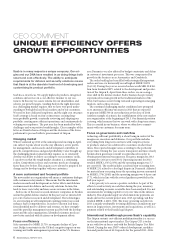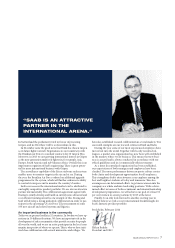Saab 2013 Annual Report Download - page 20
Download and view the complete annual report
Please find page 20 of the 2013 Saab annual report below. You can navigate through the pages in the report by either clicking on the pages listed below, or by using the keyword search tool below to find specific information within the annual report.
16 SAAB ANNUAL REPORT 2013
Strained national budgets – an advantage for
cost-efficient products
Defence spending has decreased for the past ve years, according
to IHS Jane’s Defence & Security. With Western countries’ decli-
ning defence budgets, the traditional view that the best defence
and security solutions are the ones that cost the most money
is shiing towards demanding more value for the money. is
makes it particularly important to incorporate cost-eciency as
a production design parameter. Multifunctional products are one
example of this, designed as they are to solve several dierent
tasks, as opposed to traditional defence products designed to
handle only one specic task and oer protection against one
specic threat. Another key aspect is lead times - shorter lead
times mean lower development costs, which are reected in
product price.
Demand for local presence with regional focus
Despite the stagnation of global military spending, some regions
such as Asia, the Middle East and Latin America, are expe-
riencing growth. Increased defence spending in growth markets
is attracting international defence companies competing to sell
their products. Local presence and a regional focus are therefore
necessary elements to ideally adapt the oer to customers’ needs.
New co-operation and alliances call for system
integration
More and more countries are moving away from having armed
forces for the primary purpose of safeguarding national borders
and territory towards having armed forces able to participate in
international operations such as international community pea-
cekeeping and economic development missions. When dierent
defence forces operate together, their systems need to be co-
ordinated and integrated operationally. ere is therefore rising
demand for open systems and system integration.
Increased need to safeguard supply chains and
make them more efficient
Growing transnational ows of goods, energy, capital, people and
information in an increasingly globalised world heightens the
need for security and eciency. is applies not only to safeguar-
ding infrastructure for strategic ows from military threats and
terrorism, but also to satisfying functional requirements such
as making ows more secure and ecient at key hubs. Without
exception, strategic ows of goods and resources are playing an
increasingly prominent role in the security mind-set of countries
and organisations. Added to this is the need to safeguard critical
systems from cyber-attacks.
Convergence of civilian and military sectors
In many ways, the lines dividing civilian and military are being
rubbed out. is is partly due to rapid developments in informa-
tion and communication technology (ICT). Defence companies
need to utilise their high-tech expertise to win a place in the ex-
panded security industry. Ultimately, technology will be the de-
termining factor in terms of who wins the contract when civilian
and military companies meet in competition. Another key factor
shared by civilian and military strategies is identifying sustaina-
ble solutions and safeguards against environmental threats.
Market
driving forces Business flow
Saab’s offering
and strengths
Market area
organisation
SAAB’S BUSINESS MODEL
TECHNOLOGIES THAT MEET
THE NEEDS OF THE MARKET
The driving forces in Saab’s markets are linked to altered threat scenarios and new societal
security needs. Defence spending in Western countries has decreased due to the economic
trend, while investments are on the rise in other parts of the world. This increases demands
for cost-efciency and the ability to anticipate and respond to changing customer needs.
Market driving forces
Military spending 2008–2017
Total global defence expenditure in 2013 totalled USD 1,530 billion, which is 7.1 per
cent less than the spending in 2009. Another 1.8 per cent decline is expected by the
end of 2015, before global defence spending is predicted to increase again.
Source: IHS Jane’s Aerospace, Defence & Security, Defence Budgets Annual Report 2013
2,000
USD
billion
1,500
1,000
500
0
2008 2013 2017 E
North America
Asia
West Europe
East Europe
Middle East and North Africa
South America
Oceania
Sub-Saharan Africa
























